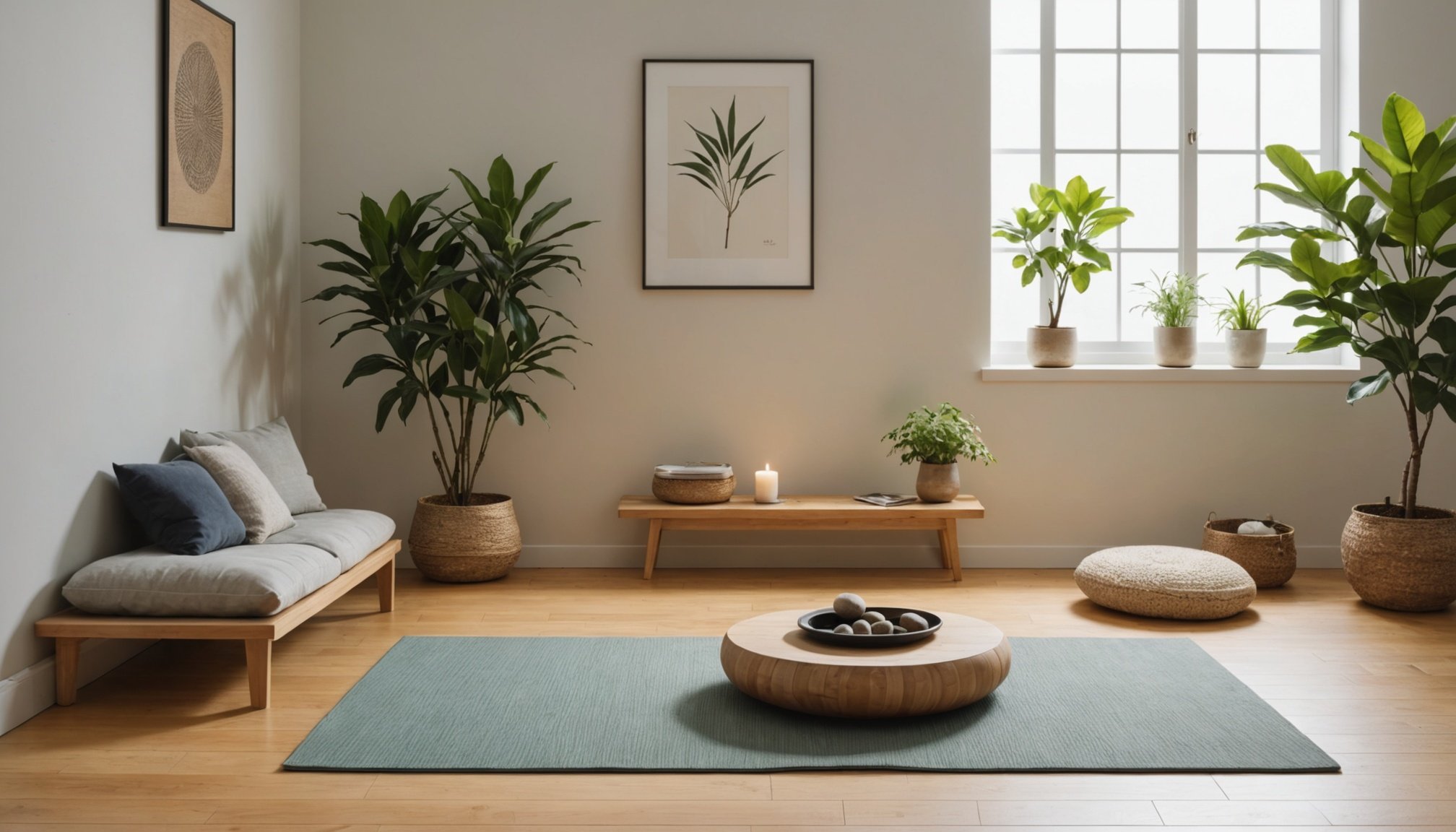Transform Your High-Traffic Home into a Serene Zen Meditation Corner
In the hustle and bustle of modern life, finding a moment of peace and tranquility can be a daunting task. However, with a few thoughtful design choices and some practical tips, you can transform even the most high-traffic areas of your home into a serene Zen meditation corner. Here’s how you can create a calming oasis that nurtures your mind, body, and soul.
Choosing the Right Location
When it comes to creating a meditation room or corner, the location is crucial. You need a space that is calm, clutter-free, and ideally, away from the main traffic flow of your home.
Additional reading : Smart Solutions for a Stylish Minimalist Entryway with Ultimate Storage Potential
Consider the Flow of Your Home
Think about the areas of your home that are less frequented or can be easily isolated from the rest of the house. For example, a spare room, a corner of your bedroom, or even a section of your backyard can be perfect for a meditation space.
Minimize Distractions
Ensure that the chosen space is free from distractions such as TVs, computers, and other electronic devices. The goal is to create an environment that promotes mindfulness and relaxation, not one that encourages multitasking or entertainment.
In parallel : Ultimate Guide to Crafting Your Ideal DIY Garage Workshop: Top Design Tips and Strategies
Designing Your Zen Space
The design of your meditation space is where the magic happens. Here are some key elements to consider:
Calming Colors
Colors play a significant role in setting the mood of your space. Opt for calming and natural hues such as pale grays, earthy greens, putty beiges, and sky blues. These colors are inspired by nature and help in creating a peaceful atmosphere. Sometimes, a vibrant pop of color like lavender or yellow can be used as an accent, but it should be sparingly applied to avoid creating too much energetic attention.
Natural Elements
Incorporating natural elements is essential for a Zen space. Consider using raw, earthy surfaces and nature-inspired textures for your furniture, walls, and decor. Wood products with natural grain patterns, such as gray stained hickory or natural bamboo, can add warmth and coziness to your space. Additionally, natural materials like stone and natural fabrics can enhance the feeling of comfort and relaxation.
Soft Lighting
Soft lighting can significantly enhance the calming ambiance of your meditation space. While natural light is preferred, additional light sources like hanging or floor lamps can also be valuable. Opt for soft, warm lighting that creates a cozy and inviting atmosphere. Wabi-sabi principles suggest using soft colors and lighting to add harmony and relaxation to your interior.
Adding Decor and Accessories
The decor and accessories you choose can make or break the tranquility of your meditation space. Here are some tips to help you get it right:
Minimalistic Approach
Adopt a minimalistic approach to decor. Remove clutter and keep only the items that you need or feel an emotional attachment to. This strategy helps in reducing stress and creating a more peaceful environment.
Inspirational Elements
Personalize your space with inspirational elements such as inspirational phrases, crystals, scented candles, or essential oils. These elements can help in creating a positive and calming atmosphere. For example, lavender essential oil is known for its calming properties and can be used to enhance your meditation practice.
Nature-Inspired Decor
Incorporate nature-inspired decor such as hard-to-kill houseplants or stones. These elements bring a touch of nature into your space and help in creating a serene environment. Sarah Jacquelyn, an interior designer, uses a mix of greenery in her personal meditation room to achieve this effect.
Creating a Focal Point
A focal point in your meditation space can help in directing your attention and enhancing your practice.
Altar or Artwork
Establish a focal point that has significance, such as an altar or a piece of artwork. This could be a Buddha statue, a meditation bell, or any other item that resonates with your spiritual or personal beliefs. Ashton Horejs of AshtonForDesign suggests painting the walls a soothing hue and adding a focal point to create a calming space.
Meditative Pods
For a more modern and innovative approach, consider using meditative pods. The Iris pod, designed by Deepak Chopra and Yves Behar, offers a tranquil sanctuary with essential oils, immersive sound and light tech, and guided meditations. These pods can be placed in high-traffic areas like offices or homes to provide a peaceful retreat.
Utilizing Outdoor Spaces
If you have an outdoor space, you can transform it into a serene Zen corner as well.
Artificial Turf
Artificial turf can be used to create a lush, low-maintenance retreat on your balcony or patio. It provides a soft, green surface that contrasts beautifully with foliage and other outdoor decor. This can be an ideal option for urban dwellers who want the ambiance of a garden without the maintenance.
Outdoor Furniture
Combine the artificial turf with comfortable outdoor furniture and colorful accents to make the space inviting yet chic. Add elements like wind chimes, outdoor cushions, or a small water feature to enhance the zen vibe of your outdoor space.
Practical Tips for Enhancing Your Meditation Practice
Here are some practical tips to help you enhance your meditation practice in your newly created Zen space:
Remove Clutter
Keep your space clutter-free. Clutter can distract you and make it difficult to focus on your meditation practice. Mandi Juskiewicz advises removing clutter and keeping only the things you need and feel an emotional attachment to.
Use Soft Furnishings
Add soft furnishings such as throw blankets, pillows, or cushions to create a comfortable and cozy environment. These can help you relax and focus during your meditation sessions.
Incorporate Sound
Sound can play a significant role in enhancing your meditation practice. Consider using meditation chairs like the “Goyo” chair, which features a bowl-like shape that produces soft, soothing sounds when struck. Alternatively, you can use guided meditations or nature sounds to create a calming atmosphere.
Table: Comparing Different Meditation Space Ideas
| Meditation Space Idea | Key Features | Benefits | Challenges |
|---|---|---|---|
| Zen Room | Calming colors, natural elements, soft lighting | Promotes relaxation, reduces stress | Requires dedicated space |
| Meditative Pods | Essential oils, immersive sound and light tech, guided meditations | Provides a tranquil sanctuary, enhances workflow | Can be expensive, limited space |
| Outdoor Zen Corner | Artificial turf, comfortable outdoor furniture, nature-inspired decor | Offers a natural ambiance, low maintenance | Weather conditions, limited privacy |
| Minimalistic Room | Clutter-free space, soft colors, natural materials | Reduces stress, promotes mindfulness | Requires discipline to maintain minimalism |
| Boho Meditation Space | Rattan daybed, string lights, crystals, plants | Creates a cozy and inviting atmosphere, promotes relaxation | Can be overwhelming if not balanced |
Detailed Bullet Point List: Elements to Include in Your Zen Space
-
Natural Colors:
-
Pale grays
-
Earthy greens
-
Putty beiges
-
Sky blues
-
Bright whites or off-whites
-
Natural Elements:
-
Wood products with natural grain patterns
-
Stone
-
Natural fabrics
-
Hard-to-kill houseplants
-
Stones
-
Soft Lighting:
-
Natural light
-
Hanging or floor lamps
-
Soft, warm lighting
-
Minimalistic Decor:
-
Remove clutter
-
Keep only essential items
-
Inspirational phrases
-
Crystals
-
Scented candles
-
Essential oils
-
Focal Point:
-
Altar
-
Artwork
-
Buddha statue
-
Meditation bell
-
Comfortable Furnishings:
-
Throw blankets
-
Pillows
-
Cushions
-
Floor sofa or low-to-the-ground couches
-
Outdoor Elements:
-
Artificial turf
-
Comfortable outdoor furniture
-
Wind chimes
-
Small water feature
Quotes and Insights from Experts
- “Your home is your fortress that should protect you from all external stresses and give you the feeling of relaxation and peace.” – Mandi Juskiewicz
- “When selecting your Zen color scheme, think of the elements that remind you of natural river rock, weathered driftwood, sandy beaches, and lush forests.” – Jennifer Emmer
- “The overall space should feel bright and calm. Don’t mix so many different elements that the bedroom design becomes too ‘energetic’.” – Jennifer Emmer
- “Incorporate natural elements like wood, stone and natural fabrics to add the feeling of warmth and comfort.” – Mandi Juskiewicz
Transforming your high-traffic home into a serene Zen meditation corner is not just about creating a peaceful space; it’s about cultivating a mindset that values mindfulness and relaxation. By choosing the right location, designing your space with calming colors and natural elements, and incorporating practical tips and accessories, you can enhance your meditation practice and bring more tranquility into your life.
Remember, the key to a successful Zen space is balance and simplicity. Keep your space clutter-free, use soft furnishings, and incorporate natural elements to create an environment that invites relaxation and mindfulness. Whether you’re using a dedicated room or a corner of your home, the goal is to create a space that helps you connect with your inner self and find serenity in the midst of chaos.











